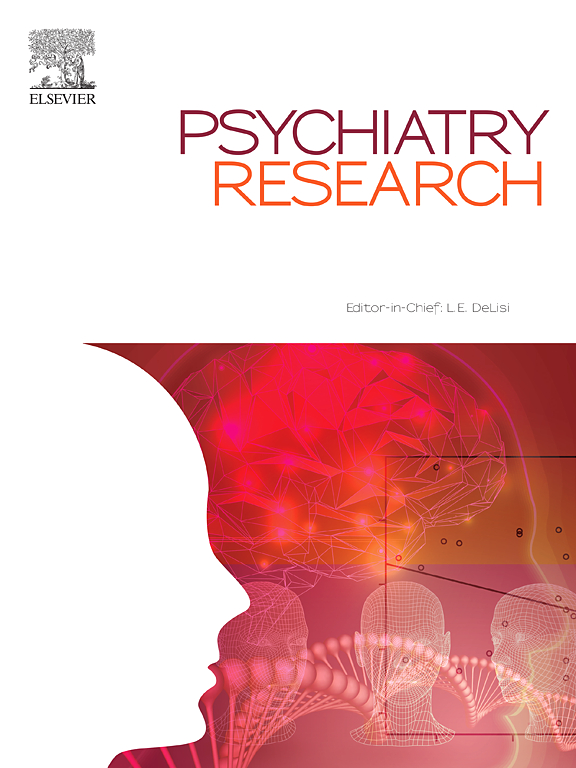Catatonia in autism spectrum disorders: Prevalence, functional impact, and diagnostic insights
IF 3.9
2区 医学
Q1 PSYCHIATRY
引用次数: 0
Abstract
The current study aimed to evaluate subtle catatonia behaviors and functionality in adolescents with autism spectrum disorders (ASD). The sample consisted of 48 patients (11 female, 37 male) aged 12–18 (13.77 ± 2.01). DSM-5 catatonia criteria and Bush-Francis Catatonia Rating Scale (BCRS) was utilized to assess catatonia, while the impairment in functionality was appraised using the Global Assessment Scale. Parents fulfilled the Revised Child Anxiety and Depression Scale-Parent version (RCADS-PV) and Repetitive Behavior Scale-Revised (RBS-R). The presence of catatonia was detected in 18 out of 48 (37.5 %) participants according to BCRS, and in 16 cases (35.4 %) according to DSM-5 criteria. A significant association between two diagnostic tools was observed (p < 0.001). In the group with mild impairment in functionality, 2 cases had catatonia (12.5 %), while in the group with more impaired functionality, 16 cases (50 %) had catatonia (p = 0.011) according to BCRS. Major depressive disorder subscale scores of RCADS-PV and stereotypic movements (RBS-R) were correlated with the presence of catatonia (p < 0.05). The findings suggest a higher prevalence of catatonia in ASD, and a potential correlation between the presence of catatonia and functionality. More research is warranted to highlight the presence and course of catatonia beginning from the early years of ASD.
自闭症谱系障碍中的紧张症:发病率、对功能的影响和诊断见解。
本研究旨在评估自闭症谱系障碍(ASD)青少年的细微紧张症行为和功能。样本包括 48 名患者(11 名女性,37 名男性),年龄在 12-18 岁之间(13.77 ± 2.01)。采用DSM-5紧张症标准和布什-弗朗西斯紧张症评定量表(BCRS)评估紧张症,并使用全球评估量表评估功能受损情况。家长符合修订版儿童焦虑抑郁量表-家长版(RCADS-PV)和重复行为量表-修订版(RBS-R)的要求。48 名参与者中有 18 人(37.5%)根据 BCRS 发现患有紧张症,16 人(35.4%)根据 DSM-5 标准发现患有紧张症。两种诊断工具之间存在明显关联(p < 0.001)。根据 BCRS,功能轻度受损组中有 2 例(12.5%)患有紧张症,而功能受损较严重组中有 16 例(50%)患有紧张症(p = 0.011)。RCADS-PV的重度抑郁障碍分量表得分和刻板动作(RBS-R)与紧张症的存在相关(p < 0.05)。研究结果表明,紧张症在 ASD 中的发病率较高,而且紧张症的存在与功能之间可能存在相关性。有必要开展更多的研究,以突出自闭症早期开始的紧张症的存在和病程。
本文章由计算机程序翻译,如有差异,请以英文原文为准。
求助全文
约1分钟内获得全文
求助全文
来源期刊

Psychiatry Research
医学-精神病学
CiteScore
17.40
自引率
1.80%
发文量
527
审稿时长
57 days
期刊介绍:
Psychiatry Research offers swift publication of comprehensive research reports and reviews within the field of psychiatry.
The scope of the journal encompasses:
Biochemical, physiological, neuroanatomic, genetic, neurocognitive, and psychosocial determinants of psychiatric disorders.
Diagnostic assessments of psychiatric disorders.
Evaluations that pursue hypotheses about the cause or causes of psychiatric diseases.
Evaluations of pharmacologic and non-pharmacologic psychiatric treatments.
Basic neuroscience studies related to animal or neurochemical models for psychiatric disorders.
Methodological advances, such as instrumentation, clinical scales, and assays directly applicable to psychiatric research.
 求助内容:
求助内容: 应助结果提醒方式:
应助结果提醒方式:


